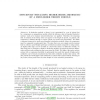100 search results - page 3 / 20 » Representing First-Order Logic Using Graphs |
IJCAI
2007
13 years 7 months ago
2007
We present a fully connectionist system for the learning of first-order logic programs and the generation of corresponding models: Given a program and a set of training examples,...
AAAI
2006
13 years 7 months ago
2006
Temporally extended goals (TEGs) refer to properties that must hold over intermediate and/or final states of a plan. The problem of planning with TEGs is of renewed interest becau...
IJCAI
2001
13 years 7 months ago
2001
We present a dynamic programming approach for the solution of first-order Markov decisions processes. This technique uses an MDP whose dynamics is represented in a variant of the ...
CORR
2008
Springer
13 years 4 months ago
2008
Springer
In deduction modulo, a theory is not represented by a set of axioms but by a congruence on propositions modulo which the inference rules of standard deductive systems--such as for ...
FLAIRS
2008
13 years 8 months ago
2008
One of the major weaknesses of current research on the Semantic Web (SW) is the lack of proper means to represent and reason with uncertainty. A number of recent efforts from the ...

